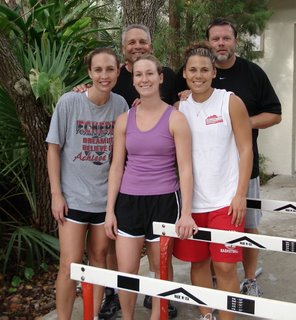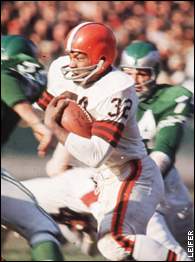Calvin is National Fitness Coach with British Rugby Football Union. Calvin has a PhD. In Biomechanics and has an extensive background in track & field. I think Calvin is one of the brightest minds in the field. He does a great job of combining science and practice. He and Dave redden make a great team working with British Rugby.
What are most essential requirements for a successful conditioning program?
True consideration for the athlete's needs, both psychological and physical is absolutely critical. Some athletes need a lot of motivating to train, while others need none. Some like a lot of work, some like very little. The programme has to take this into consideration, otherwise it is doomed to fail or at best be ineffective in the long-run. A programme also needs a goal to work towards. Athlete's need assessing before starting the programme, and their future goals need establishing at the outset. Without these, the programme might be enjoyable and offer certain physical benefits to the athlete, but it will be without direction. How the effectiveness of the programme will be assessed on completion is also a strong requirement.
What are the most common mistakes in conditioning?
Not to plan. Not to treat the athlete as an individual, and not to listen to them as they go through the programme. This is especially prevalent in team sports where training tends to be done as a group, and programmes get generalised. Not goal setting and evaluating the programmes is also a mistake. They don't stop a person from benefiting from a programme, but you never really now why or how much they've improved.
What is “functional training” from your point of view?
Training that enables an individual to perform better relative to their training goal (their sport, hobby, health or wellbeing)
What do you do to make your training more functional?
Compare training improvements to the performances in matches. We are lucky to have a sophisticated match analysis system. We can tell very easily if an athlete's improvement in an anaerobic capacity test had carried over to an improved work rate in subsequent matches. In the training setting, we try to create drills that incorporate aspects of the game, and match the game in regard to time, distance, and the movements involved.
For training that is less functional but important to an athlete's development, it is important that the athlete understands why they need to do it, and believes in its efficacy.
How important is specificity?
This really depends upon the factors that are limiting the athlete's ability to improve at their sport. For example, a very weak athlete might improve their sprinting ability by working on leg strength. They might have the coordination to recruit high order motor units and the ability to sequence muscular contractions to move their legs at their maximum pace. But their ability to produce force might be poor. Improving leg strength in a seemingly 'unspecific' manner (e.g squat, power clean) might well be a great way to resolve this problem.
Specificity should also not be confused with 'looks like'. Too many coaches try to train athletes with exercises that 'look' like movements in the sport, but the body positions adopted do not enable a training overload to occur, and are potentially confusing to the motor system.
The simplest way to deal with this question is to ask the question, "What specifically is preventing the improvement in performance of your athlete." A sensible choice of training mode should fall naturally out of this question.
What aspect of conditioning athletes is most difficult and how have you tried to address it?
Lack of contact is the biggest obstacle. There is no real way around this other than both parties doing what they can to communicate regularly.
Also motivating athletes to train after disappointing sporting performances can be difficult. I try to find the positives out of the performance, and the preparation before the performance and work on these to start with. Once the athlete's frame of mind has changed to being more positive once more, then their more glaring weaknesses can be addressed again.
With the plethora of information available how can a coach determine what is best?
Find a good mentor to start with - it saves a lot of time. Do not try to change too many things at once in an athlete's programme, and also evaluate after the end of training cycles. Find out what your prescription has done for the athlete. Have a very solid reason for including something in an athlete's programme. If it doesn't fully stack up in your logic, don't include it.
Where do you stand on nature versus nurture? How much difference can training make?
Elite athletes do not get where they are through training alone, they have the genes that give them a natural advantage. That said, it is more often than not, the athletes who are prepared to put the most into their training, and get the best out of whatever genes they were blessed with, that are the most successful. They often make the nicest people too.
What is the sure sign that a self proclaimed conditioning guru is not a good source of advice?
The willingness to discredit almost everyone else in their profession.
What has been the biggest innovation in training that you have seen during the course of your career and where is the biggest room for innovation in training athletes?
Probably the internet - the ability to communicate with people and share ideas has never been so easy. Of course, it's also great for publicizing rubbish so care must be taken with what one reads over the web.
As for innovation in training I think we will develop a better appreciation of the restorative processes of the body over the next few years. This will much enhance our ability to write effective programmes. As for what will probably be the most impacting area of research in the near future - i think it will be hard to discount genetics. As to whether this impact will be good or bad is too early too say.
What's the biggest issue in training athletes today?
Everyone wants a short-cut.
Who has been a role model in your career and why?
Steve Backley - the great British javelin thrower. A fantastic competitor who always seemed to be able to do his best when it mattered most. That he felt that it was simply a choice not chance that he could achieve these performances made him an inspiring athlete to work with. From Steve's technical coach, John Trower, i learned how important it was to be enthusiastic and positive at every coaching session. Athletes don't always bring this themselves. From Sir Clive Woodward I learned how important it was to take care of details that often seemed insignificant and unimportant - to you they might be, but not to the athlete. As for coaches who have shaped my philosophy on training methods, I would include Mike Stone, Malcolm Arnold, Vern Gambetta, and my current work colleague, Dave Reddin.
What are the biggest professional challenges have you had to face?
Influencing an athlete's training practices from afar - it is very difficult.
What do you enjoy most about coaching? Dislike?
Most like - The continued inspiration of working with athletes who day in, day out, push themselves to incredible levels of fatigue in the pursuit of personal development. As for dislikes, there aren't many, but I hate writing training programmes. Designing them is the fun part, writing them down once you've done this, is the pain.
Did there come a time in your career where you were faced with a "fork in the road?" If so, do you ever revisit the decision you made or didn't make?
I think that you should also feel that you can be effective in your coaching role. If this is not the case you should find a new role, or change the current one in a way that makes you effective again. I've been there a couple of times in my career so far, and have only looked back confident that I made the right decision.
What inspired you to get into coaching?
A lack of success as an athlete! Also the feeling that I knew more than I was able to put into action myself.
Is failure ever valuable?
As valuable as winning if you put your heart and soul into the performance. I recently read, 'Don't die with the music in you," by the great Australian Rugby League Coach, Wayne Bennett. Wayne felt that the emphasis placed on winning in sport these days was a shame as it detracted from the efforts of the losing party. Losing isn't the issue if the preparation and effort that had gone into the performance were 100%. I'm inclined to agree.
Which changes now taking place in your field that should be encouraged, and which resisted?
That most sports have become professional has made winning even more important, and the search for the 'cutting edge' more vital. I am pro- the furthering of knowledge and the development of training practices, but I am against the treatment of athletes as expendable assets. I think more coaches should extol the virtues of long-term commitment to effective training practices, the importance of a good basic diet that is only supplemented where necessary. Athletes will not compete for ever and I think it is a coach’s duty to prepare them for life after sport.




















